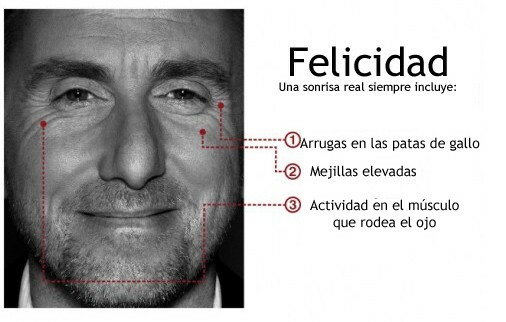Paul Ekman and the study of microexpressions
Paul Ekman He is not only one of the most media psychologists (he has participated in the development of the series Lie to Me and the movie Inside out), he is also one of the pioneers in one of the most interesting areas of behavioral science: the study of nonverbal language and, more specifically, of the microexpressions.
Knowing more about them could go a long way in improving our understanding of communication and the nature of communication. basic emotions and universal, if they really exist.
What are microexpressions?
Basically a microexpression is an involuntary and automatic facial expression and that, despite lasting less than a second, theoretically it could be used to know the emotional state of the person who performs it.
According to the ideas of Ekman and other researchers, micro expressions are universal, since they are the result of the expression of certain genes that make certain muscle groups of the face contract at the same time following a pattern each time a basic emotional state appears. Two other ideas are derived from this: that microexpressions always appear in the same way in all persons of the species. regardless of their culture, and that there is also a group of universal emotions linked to these brief gestures of the expensive.
Through the study of microexpressions, Paul Ekman has tried to see basic psychological and physiological mechanisms that theoretically they are expressed in the same way in all human societies and that, consequently, they would have a high degree of heritability genetics.
Basic emotions
The link between facial microexpressions and the 5 basic emotions proposed by Paul Ekman is based on the idea of adaptive potential: if there are a series of Well-defined emotions and a predefined way of expressing them, that means that other members of the species can recognize them and use this information for the good of their community.
In this way, dangerous situations or those in which the importance of an element of the environment causes individuals to become emotionally highly activatedOthers will be able to know instantly that something is happening, and will start looking for clues to know in greater detail what is happening. This idea is not new; Charles Darwin he already advanced it in his writings about emotions in humans and animals. However, more recent researchers have specialized in this field of study, devoting much of their time and effort to analyzing this small patch of psychology and physiology.

The role of education
It should be said that it is not yet known for sure if there are universal facial microexpressions. For this, the typical behavior of the members of all the cultures that exist would have to be known in depth, and this is not the case. Furthermore, in a laboratory setting it is difficult to get people to experience the emotions that researchers want, and not others.
That is why, even though Paul Ekman has made efforts to investigate the extent to which there are universal basic emotions and facial gestures associated with them, it is always possible that there is an exception in some remote corner of the planet and the theory of universality falls apart.
However, evidence has been found that, for at least a few thousandths of a second, members of many cultures express their feelings through the same expressions.
For example, in a study published in Psychological Science carried out from the analysis of films in which it was seen how athletes who played a medal in the Olympic games behaved, it was found that everyone showed the same type of micro-expressions immediately after knowing that they had won or lost, although later each one modulated these gestures depending on the culture to which they belonged. This is exactly the essence of the microexpressions on which Paul Ekman has theorized: first a automatic and stereotyped reaction to emotional stimuli, and right after each one takes control over their gestures.
Gestures that betray us
Another of the most interesting ideas about microexpressions is that, being automatic, they cannot be "hidden" or disguised with absolute success.
That is, if a person is sufficiently trained to detect microexpressions, You will come to have a certain knowledge about the emotional state of the other person even if he tries to avoid it (Unless you cover your face, of course).
However, in practice, recognizing these microexpressions is not so simple, since in everyday situations there is a great amount of "noise" in the form of information that masks the way in which you can see how the small facial muscles of someone. In addition, specialized equipment is often required to capture a clear picture of these brief moments.
Detect microexpressions
If the micro-expressions are generated following stereotypical patterns, it is logical to think that a method can be developed to systematically identify each one of them. So in the 1970s Paul Ekman and his colleague Wallace V. Fiesen developed a system to label each type of facial movement linked to an emotional state based on the work of a Swedish anatomist named Carl-Herman Hjortsjö. This tool was called Facial Coding System (in English, FACS, from Facial Action Coding System).
However, this does not mean, by any means, that they can be detect lies just identifying micro-expressions, and let's not talk about something similar to reading thoughts. The fact that these gestures are automatic due to the expression of genes means that, at the same time, the information provided by the micro-expressions is tremendously ambiguous, since the details of the context are not "translated" through the muscular movements in the face.
A microexpression can be an indication to know if someone is sad or not at a certain moment, but it does not tell us anything about what causes that feeling. The same happens with the microexpressions linked to the afraid. They can be an indicator that it is feared that the lies that have been told will be exposed, or they can also express the fear that we believe that what has been told are lies.
As always, the study of human behavior seldom progresses by leaps and bounds, and the work of Paul Ekman on microexpressions is nothing like a Rosetta stone of states mental. It can serve, yes, to learn more about our genetic predispositions when it comes to expressing emotions, and can also be studied to learn patterns of empathy and improved communication. However, as by definition micro-expressions are automatic and unconscious, it would be impossible to directly influence them.



